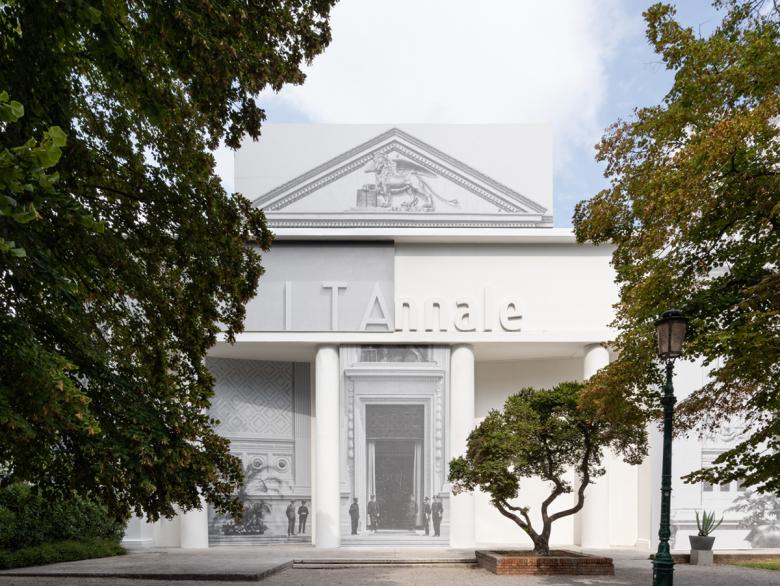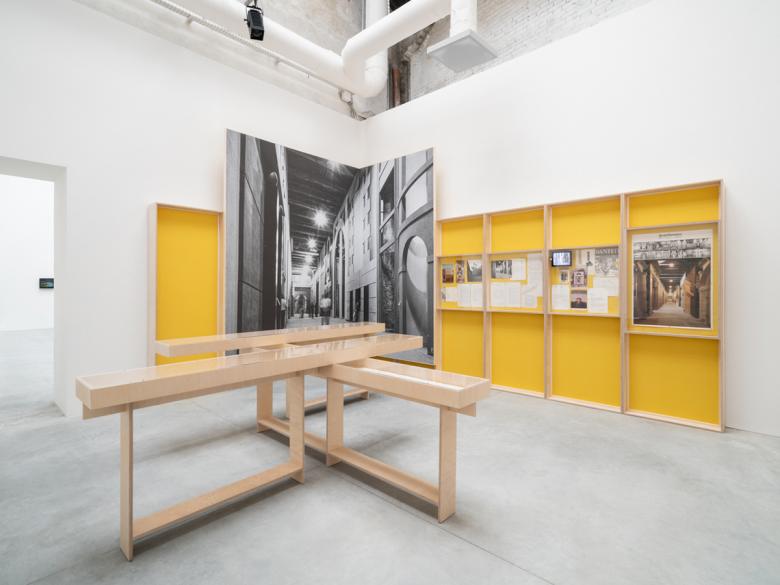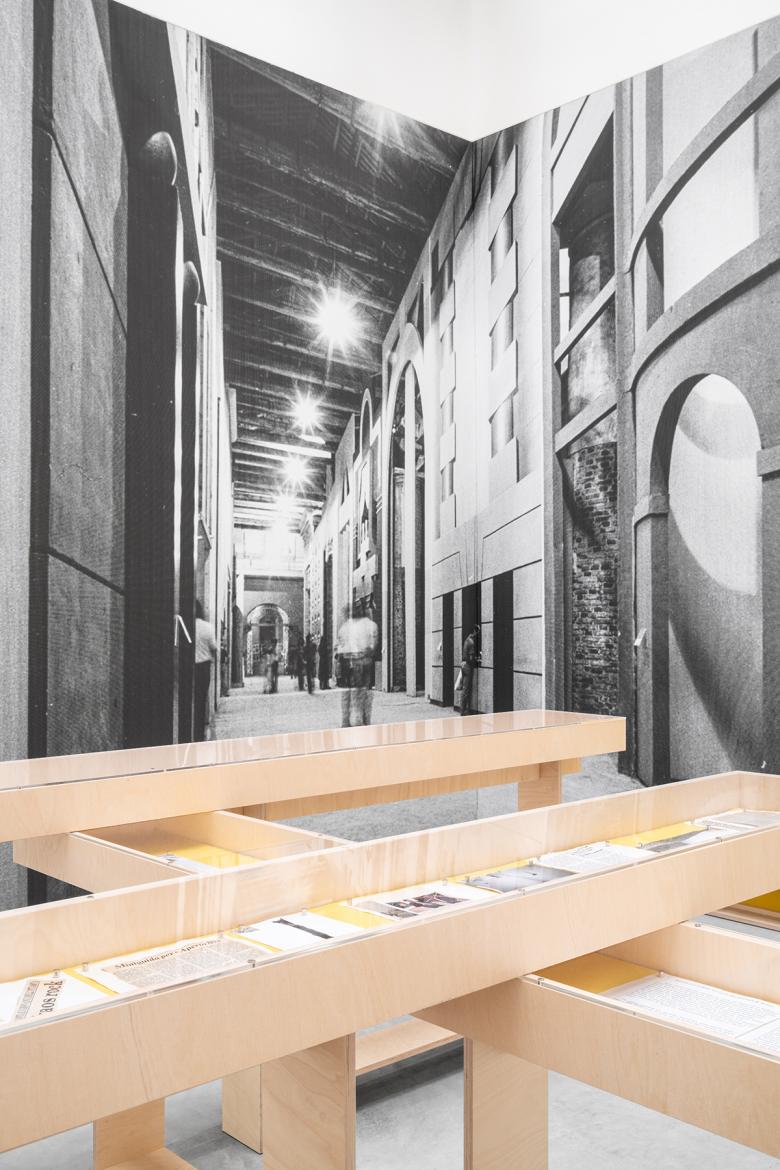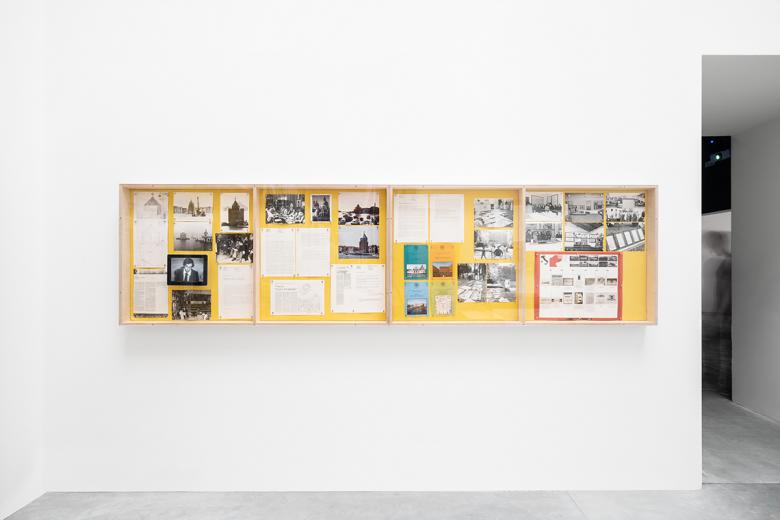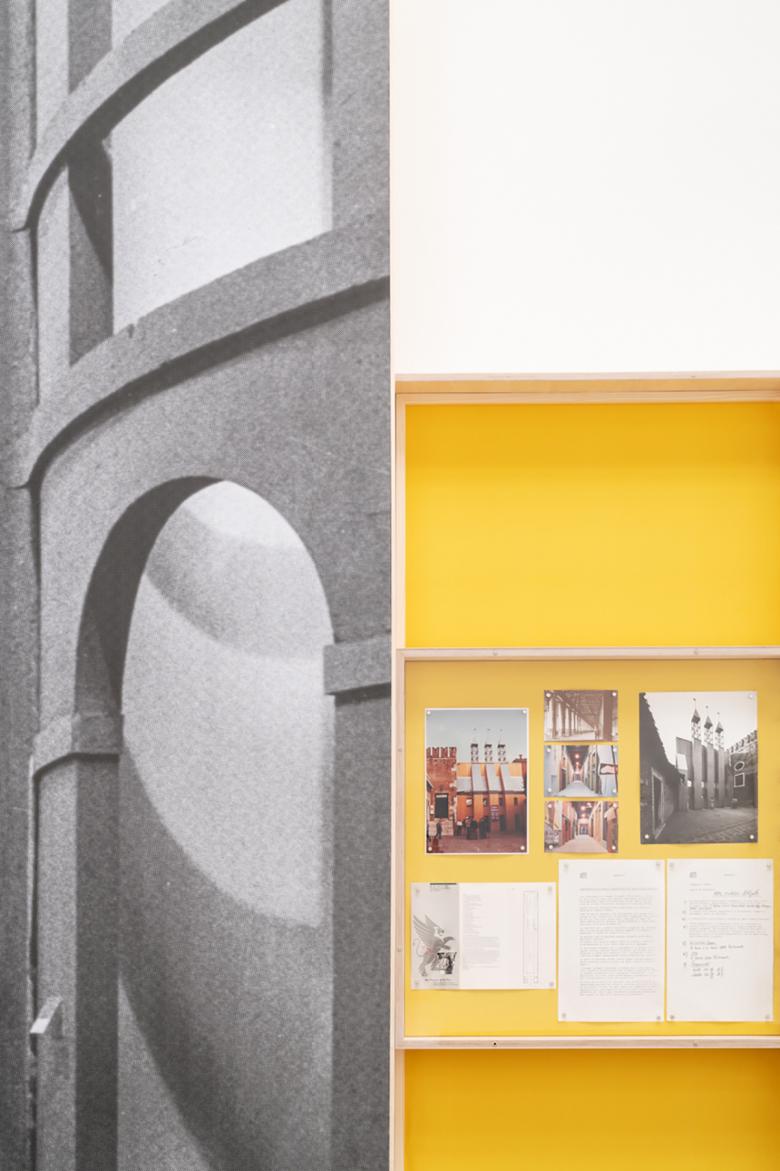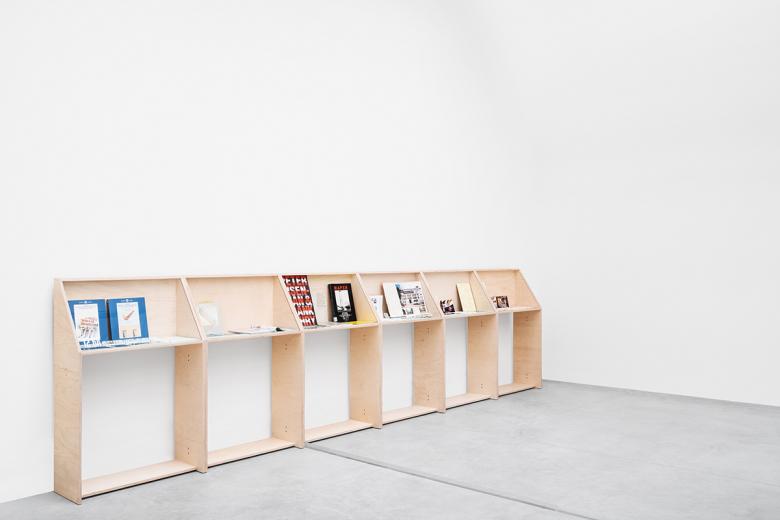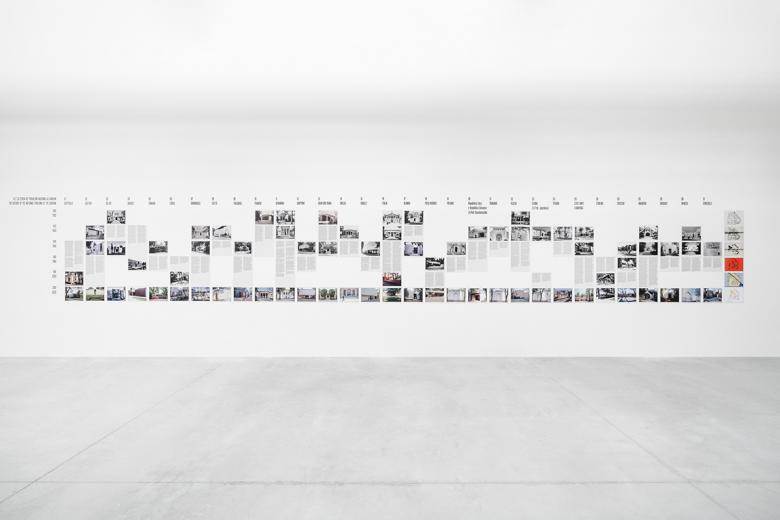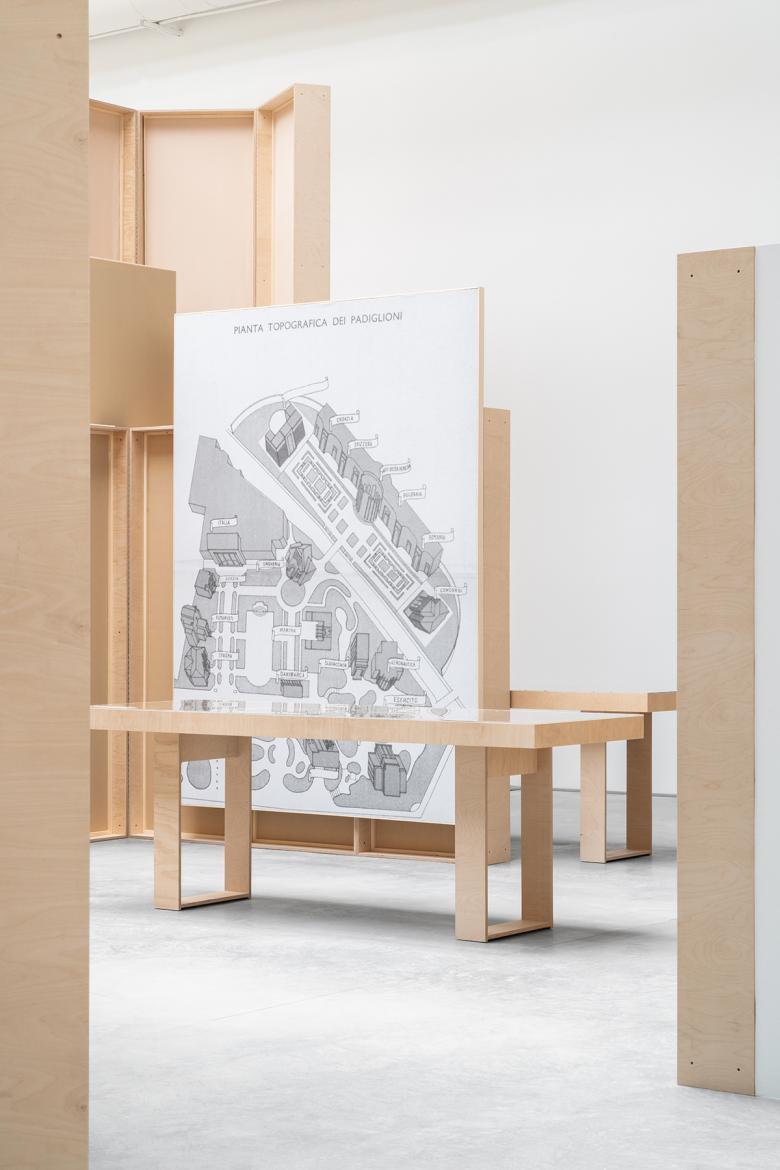'The Disquieted Muses' – A Remote Review
John Hill
10. September 2020
The entrance to the Central Pavilion in Giardini della Biennale during The Disquieted Muses. (Photo: Marco Cappelletti, courtesy of La Biennale di Venezia)
Although The Disquieted Muses: When La Biennale di Venezia Meets History opened to the public on August 29, restricted travel during the coronavirus pandemic makes seeing non-local exhibitions difficult. In turn, World-Architects editor John Hill, based in New York, took a remote glance at The Disquieted Muses, using photographs and printed literature to learn something about the Biennale's history as it pertains to architecture.
Everyone remembers their first visit to the Venice Architecture Biennale. Mine was in 2012, when British architect David Chipperfield asked participants to consider the "Common Ground" among the architectural profession as well as between the profession and the public. For the late William Menking, who co-founded The Architect's Newspaper and was a staple at every Biennale I've ever been to, it was in 1980, according to an obituary earlier this year that said he "literally attended every Venice Architecture Biennale since it started in 1980." Beyond attending and writing about the Biennales, Menking co-curated the US National Pavilion in 2008, an experience that led him, with fellow curator Aaron Levy, to undergo an oral history of the Biennales of Architecture. The fruits of the interviews they conducted with ten curators and its longtime director Paolo Baratta were compiled in Architecture on Display: On the History of the Venice Beinnale of Architecture, published by the Architectural Association in 2010.
Room 8: "The First International Architecture Exhibition and Postmodernism, 1980." (Photo: Marco Cappelletti, courtesy of La Biennale di Venezia)
Reading Architecture on Display years ago taught me that, while 1980 was considered the first official Venice Architecture Biennale, it was preceded by a trio of architectural exhibitions curated by Vittorio Gregotti, the Italian architect who also died earlier this year and who was given a posthumous Golden Lion a few days after the opening of The Disquieted Muses. Gregotti recalled to Menking and Levy in their 2009 interview how he was asked in 1974 to curate the art exhibition, something usually done by actual art curators, but he would only do it if an architectural component was included. Coming after some years of interruption following the 1968 protests, Gregotti's Concepts for the Molino Stucky in 1975, which presented proposals by architects and artist for reusing a late 19th-century flour mill on Guidecca, was politically minded and socially engaged, involving the residents of Venice by considering the future of a historical piece of the city. As described in the brochure (PDF link) accompanying The Disquieted Muses, the Molino Stucky project came after a time of great political and social tensions, and it intentionally mingled such disciplines as art, architecture, and urban planning.
Room 8, with a large photograph of Strada Novissima. (Photo: Marco Cappelletti, courtesy of La Biennale di Venezia)
The intermingling of disciplines is also on display in the current exhibition in the Central Pavilion in Giardini della Biennale. Curated by the artistic directors of the Biennale's six departments (art, architecture, cinema, dance, music, and theater), The Disquieted Muses takes visitors "on a journey through the archive of La Biennale di Venezia, focusing on key moments when the wars, upheavals, generational conflicts and profound cultural transformations of the twentieth century reshaped the boundaries of this Venetian institution." Although the Venice Biennale has a 125-year history, in the exhibition these key moments start in the interwar years and carry through into the 1990s, providing a roughly half-century history of the institution and its various departments. The responsibility for the history of the Venice Architecture Biennale fell to Hashim Sarkis, artistic director for the 17th International Architecture Exhibition, How will we live together?, which was delayed from this year until 2021.
Archival materials in Room 8 showing, in the left half, Aldo Rossi's Teatro del Mondo from 1979. (Photo: Marco Cappelletti, courtesy of La Biennale di Venezia)
Like Menking and Levy, Sarkis marks the beginning of architecture in the Biennale in 1975, with Gregotti's Molino Stucky exhibition held at Magazzini del Sale on the Zattere. In addition to the display of proposals, none of which came to fruition (the old mill was converted into a luxury hotel that opened in 2007), artists Mario Ceroli and Gianfranco Fini created a "happening" by building a large wooden crate in Piazza San Marco that bore the names of all the artists participating in the exhibition. Later, per the brochure, "this huge structure was transported by boat to the Giudecca shipyards and set on fire, and the charred remains were then placed in the Magazzini del Sale." One year later, Gregotti's second architecture exhibition, Rationalism and Italian Architecture in the Fascist Period, 1919-42, was displayed in the deconsecrated church of San Lorenzo. Here, the relationship between architecture and political power was made explicit, with part of the exhibition highlighting "the Fascist regime’s interference in architectural culture."
Another view of Room 8, with photographs of Aldo Rossi's entrance portal to the Arsenale in 1980. (Photo: Marco Cappelletti, courtesy of La Biennale di Venezia)
Room 8 is devoted to the 1st International Architecture Exhibition held in 1980 and curated by Italian architect Paolo Portoghesi under then Biennale president Giuseppe Galasso. The Presence of the Past occupied the Corderie of the Arsenale, the first time the Biennale used the impressive building as a venue, one it continues to use to this day, adding much-needed space beyond the Central Pavilion and national pavilions in the Giardini. The long Corderie was a fitting setting for Portoghesi's Strada Novissima, a 70-meter-long "Main Street" lined with three-story facades designed by a bevy of now name-brand architects (Frank Gehry, Michael Graves, Rem Koolhaas, Robert Venturi and Denise Scott Brown, to name a few) and erected by set builders from Rome’s Cinecittà Studios. The brilliant yet controversial display clearly expressed the Postmodernist tendencies overtaking architecture at the time and it gave international exposure to the first Biennale of Architecture, ensuring it would continue, alternating with the Biennale of Art.
Room 12 and materials related to the national pavilions participating in the Venice Architecture Biennale for the first time. (Photo: Marco Cappelletti, courtesy of La Biennale di Venezia)
The Strada Novissima was just one part of the 1980 Biennale. Its most famous companion was the Teatro del Mondo that Aldo Rossi designed for Portoghesi's Venice and Theatrical Space exhibition in 1979 and was reused for performances one year later. The brochure boasts of the floating theater as "probably the most famous temporary work of the twentieth century," not just in the realm of architecture. Rossi also designed an entrance portal to the Arsenale for the 1980 exhibition, and a few years later Portoghesi brought Rossi once again into the Biennale fold, selecting him as curator of the 3rd International Exhibition, Designing Venice, which took place in 1985. It is described in the brochure as a competition that invited architects "to present innovative ideas and designs that dealt with the issue of fitting the new into the old, of innovative architecture within historic contexts, and of Venice’s relationship with its hinterland." Rossi chaired a jury that selected winners from the roughly 1,500 submitted projects, awarding "Stone Lions" to designs by Robert Venturi, Raimund Abraham, Daniel Libeskind, Peter Eisenman, and others. He then mounted posters with images of the winning along the avenue leading to the Central Pavilion.
A timeline of the more than 100-year history of the national pavilions in the Giardini. (Photo: Marco Cappelletti, courtesy of La Biennale di Venezia)
Beyond the exhibitions curated by Gregotti, Portoghesi, and Rossi are two more presented in The Disquieted Muses: the untitled 5th International Architecture Exhibition curated by Francesco Dal Co in 1991 and Sensing the Future: The Architect as Seismograph, the 6th International Architecture Exhibition curated by Hans Hollein in 1996. Dal Co broke from previous iterations by inviting more than 35 countries to take part and exhibit in their national pavilions, akin to the Biennales of Art. Pavilions displaying the work of Peter Eisenman and Frank Gehry in the United States, Herzog & de Meuron in Switzerland, and Coop Himmelb(l)au in Austria, to name a few, were accompanied by Dal Co's presentation of Italian architects in the Central Pavilion and student work on display in the Corderie. Dal Co's commissioning of James Stirling for the Book Pavilion in the Giardini (it replaced one that was designed by Carlo Scarpa in 1950 but was destroyed by a fire in 1984) is easily the most lasting impact of the 1991 exhibition.
A map of the Giardini, whose pavilions include some notable works of architecture: Austrian pavilion by Josef Hoffmann (1934), Finnish pavilion by Alvar Aalto (1956), Dutch pavilion by Gerrit Rietveld (1953), Nordic pavilion by Sverre Fehn (1962). (Photo: Marco Cappelletti, courtesy of La Biennale di Venezia)
Five years later, Austrian architect Hans Hollein's exhibition pushed the international flavor of Dal Co's exhibition even further, presenting the work of around 70 architects who were "challenging the traditional idea of urban space inherited from the past." The 6th International Exhibition also had a display of the work of such "emerging voices" as Peter Zumthor and Kazuyo Sejima, who would curate the 12th International Architecture Exhibition, plus a section devoted to radical architecture from the 1960s. Ten exhibitions of architecture have followed since 1996, with the delayed exhibition curated by Hashim Sarkis being the first to veer from its every-other-year schedule since. The Disquieted Muses ends right before Paolo Baratta took over as Biennale president (he served from 1998 to 2001 then from 2008 to 2020), a time that saw the international scope and ambition of the Biennale expand greatly. A history and exhibition on those years, though, will have to wait.
Le muse inquiete (The Disquieted Muses). When La Biennale di Venezia Meets History is on display in the Central Pavilion, Giardini della Biennale from August 29 to December 8, 2020.
Related articles
-
'We must arrive at a happy contentment'
on 3/10/22
-
An Archipelago of Projects
on 9/27/21
-
'The Disquieted Muses' – A Remote Review
on 9/10/20
-
'Zaha Hadid' Opens at Palazzo Franchetti
on 5/27/16
